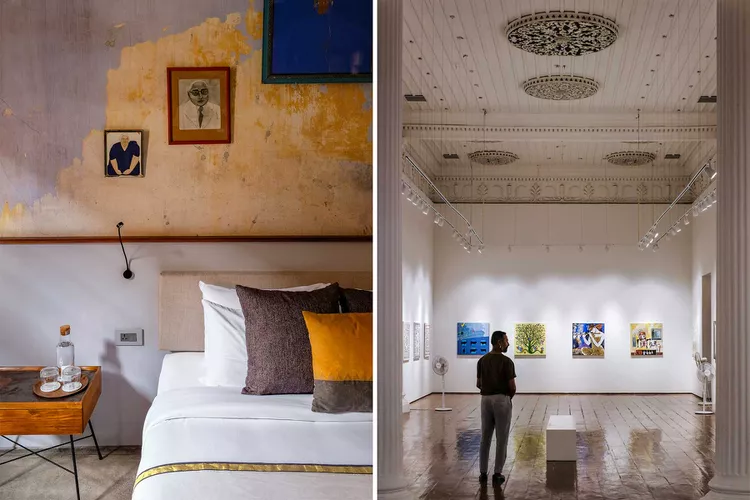Kochi’s Art Scene Revival: A Journey of Cultural Resurgence
More than two years after tourism evaporated, artists and designers are reinvigorating the city’s creative side.
“Are you sure we’re in the right place?” Himanshu, my photographer companion, asked as we dragged our suitcases down gravelly Synagogue Lane, home to Kochi’s Paradesi Synagogue. Back in 2019, the time of our visit, the 16th-century temple was the primary reason travelers went to that part of town. The Jewish community that worshipped there had largely emigrated or passed on, their homes turned into tchotchke shops for tourists or, in many cases, abandoned. Hence the skepticism.
The Allure of Mandalay Hall
However, this street was also the location of a new draw: Mandalay Hall, a boutique hotel (now a member of the Postcard group) created out of the 200-year-old shell of a landmarked family home. Designed by star Kochi architect Tony Joseph, each of its five rooms has been conceived as artists’ showcases with site-specific installations curated by Bose Krishnamachari — a founder of the Kochi-Muziris Biennale, Asia’s largest contemporary art festival. We had heard the hotel was revealing a broader trend: determined residents were using art and design to update the way visitors experience Kochi.
Halfway up Synagogue Lane, a doorway led us into a sanctuary of clean lines and minimalist design. My room at Mandalay Hall was hung with pieces by artist Jigesh Kumar, including a frame containing a sandy Coke bottle that appeared to have been excavated from the desert. (An attached note asked: “Is it an archaeological object or a contemporary work built by hand?”) Waking up the next morning, bathing, then working on my laptop, I felt like an element of the artwork.
“Prior to this, Mandalay Hall was a venue for art events,” explained Pallavi Kainady, who managed the property at the time. “So we decided to keep that going. Art is, after all, a facet of the new Kochi.”
:max_bytes(150000):strip_icc():format(webp)/mandalay-hall-KOCHI0622-19b9b4402c604d599d19e038002cfe4b.jpg)
The Expanding Art Community
Moreover, many arts operations that were open then have since become fixtures in the community, including galleries such as Kashi, David Hall, and Gallery OED, along with collectives like Via Kerala, which riffs on local cultural motifs and turns them into modern souvenirs. Contemporary designers like Sreejith Jeevan — who co-creates his Origins in Kerala line of shift dresses, caftans, and jackets with local weavers — are giving the scene a breath of fresh air.
Art Integrated into Guest Experiences
Furthermore, art has already become part of the guest experience at many hotels, such as Kayal Island Retreat, an atmospheric four-cottage property in a former artists’ residency. Owner Maneesha Panicker, who also runs the experiential tour company Silk Route Escapes, hosts dance performances by the state’s only all-female kathakali troupe and takes visitors to meet Malayali rowboat makers, who still chisel the vessels by hand.
Pandemic Impact and Resilience
The pandemic predictably put the spoke in this transformative wheel, but it hasn’t stopped it. All of the venues we visited have reopened, and February 2021 saw the debut of the Ernakulam District Heritage Museum, which is housed in a structure that was once the seat of three imperial powers: Portugal, Britain, and the Netherlands. It chronicles the dozens of ethnic communities that have called Kochi home — a history visitors can literally sample at Brunton Boatyard, a restaurant in a hotel where several cuisines come together in one thali.
:max_bytes(150000):strip_icc():format(webp)/brunton-boatyard-thali-KOCHI0622-e7fa7fc9d29f4d3ca4aa250c08e025e3.jpg)
Kochi Art Week: A New Chapter
In December, under the aegis of the Biennale, nearly a dozen galleries and museums pooled resources to organize the first Kochi Art Week: an attempt, as Bose Krishnamachari put it, to “activate both artists and audiences in the post-pandemic landscape.” The main venue was Pepper House, a 16,000-square-foot dockside warehouse transformed into a mixed-use gallery, design store, library, café, and studio. So successful was the event that Art Week will now be a permanent fixture on Kochi’s cultural calendar.
“Through the past two years, locals and domestic tourists have kept us going,” notes Aditi Nayar-Zacharias, director of the Kerala Museum, which showcased a significant collection from renowned painter Raja Ravi Varma to Art Week visitors. “I can only hope that the support continues as international visitors return.”
Conclusion
With India opening up and the next Biennale tentatively slated for December 2022, hope is certainly in the air.
A version of this story first appeared in the June 2022 issue of iBestTravel under the headline “Cultural Capital.”




